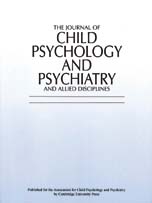Crossref Citations
This article has been cited by the following publications. This list is generated based on data provided by
Crossref.
Huikko, E.
Tuompo-Johansson, E.
Kairemo, A. C.
Piha, J.
Moilanen, I.
Räsänen, E.
Tamminen, T.
and
Almqvist, F.
1999.
Behavioural/emotional symptoms among 8–9-year-old children with somatic symptoms or illnesses as reported by their teacher.
European Child & Adolescent Psychiatry,
Vol. 8,
Issue. S4,
p.
S55.
Baker, Kristan
and
Donelly, Michelle
2001.
The Social Experiences of Children with Disability and the Influence of Environment: A framework for intervention.
Disability & Society,
Vol. 16,
Issue. 1,
p.
71.
Kroll, Thilo
and
Petermann, Franz
2001.
Förderung der sozialen und emotionalen Kompetenz bei krebskranken Kindern und Jugendlichen.
Kindheit und Entwicklung,
Vol. 10,
Issue. 1,
p.
36.
Lindsay, Geoff
Dockrell, Julie
Letchford, Becky
and
Mackie, Clare
2002.
Self esteem of children with specific speech and language difficulties.
Child Language Teaching and Therapy,
Vol. 18,
Issue. 2,
p.
125.
Nakken, Han
and
Pijl, Sip Jan
2002.
Getting along with classmates in regular schools: a review of the effects of integration on the development of social relationships.
International Journal of Inclusive Education,
Vol. 6,
Issue. 1,
p.
47.
Gordon, Anne L.
Ganesan, Vijeya
Towell, Anthony
and
Kirkham, Fenella J.
2002.
Functional Outcome Following Stroke in Children.
Journal of Child Neurology,
Vol. 17,
Issue. 6,
p.
429.
Daseking, M.
Heubrock, D.
Hetzel, A.
and
Petermann, F.
2003.
Schlaganfälle bei Kindern und Jugendlichen.
Der Nervenarzt,
Vol. 74,
Issue. 12,
p.
1088.
Monchy *, Marleen de
Pijl, Sip Jan
and
Zandberg, Tjalling
2004.
Discrepancies in judging social inclusion and bullying of pupils with behaviour problems.
European Journal of Special Needs Education,
Vol. 19,
Issue. 3,
p.
317.
Laws, Glynis
and
Kelly, Elaine
2005.
The attitudes and friendship intentions of children in United Kingdom mainstream schools towards peers with physical or intellectual disabilities.
International Journal of Disability, Development and Education,
Vol. 52,
Issue. 2,
p.
79.
Darke, Joanne
Bushby, Kate
Couteur, Ann Le
and
McConachie, Helen
2006.
Survey of behaviour problems in children with neuromuscular diseases.
European Journal of Paediatric Neurology,
Vol. 10,
Issue. 3,
p.
129.
O'Toole, Kathleen
Borden, Kristine A.
and
Miller, Carlin
2006.
Long-term psychosocial and adaptive outcomes in children with arteriovenous malformations..
Rehabilitation Psychology,
Vol. 51,
Issue. 1,
p.
60.
Pearl, Erica S.
and
Dulaney, Cynthia L.
2006.
Depressive Symptoms and Prosocial Behavior After Participation in a Bullying Prevention Program.
Journal of School Violence,
Vol. 5,
Issue. 4,
p.
3.
Sarimski, Klaus
2007.
Psychische Störungen bei behinderten Kindern und Jugendlichen - Übersicht und Schlussfolgerungen für die Psychodiagnostik.
Zeitschrift für Kinder- und Jugendpsychiatrie und Psychotherapie,
Vol. 35,
Issue. 1,
p.
19.
Sköld, A.
Josephsson, S.
Fitinghoff, H.
and
Eliasson, A.-C.
2007.
Experiences of Use of the Cerebral Palsy Hemiplegic Hand in Young Persons Treated with Upper Extremity Surgery.
Journal of Hand Therapy,
Vol. 20,
Issue. 3,
p.
262.
MSALL, MICHAEL E.
and
PARK, JENNIFER J.
2008.
Neurodevelopmental Management Strategies for Children With Cerebral Palsy: Optimizing Function, Promoting Participation, and Supporting Families.
Clinical Obstetrics & Gynecology,
Vol. 51,
Issue. 4,
p.
800.
Wong, Donna Kam Pun
2008.
Do contacts make a difference?.
Research in Developmental Disabilities,
Vol. 29,
Issue. 1,
p.
70.
Holzbauer, Jerome J.
2008.
Disability Harassment Observed by Teachers in Special Education.
Journal of Disability Policy Studies,
Vol. 19,
Issue. 3,
p.
162.
Parkes, Jackie
and
McCusker, Chris
2008.
Common psychological problems in cerebral palsy.
Paediatrics and Child Health,
Vol. 18,
Issue. 9,
p.
427.
Carran, Deborah T.
and
Kellner, Millicent H.
2009.
Characteristics of Bullies and Victims among Students with Emotional Disturbance Attending Approved Private Special Education Schools.
Behavioral Disorders,
Vol. 34,
Issue. 3,
p.
151.
Koster, Marloes
Nakken, Han
Pijl, Sip Jan
and
van Houten, Els
2009.
Being part of the peer group: a literature study focusing on the social dimension of inclusion in education.
International Journal of Inclusive Education,
Vol. 13,
Issue. 2,
p.
117.


